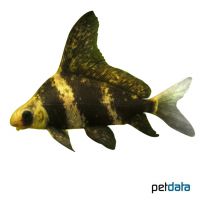Chinese Sucker (Myxocyprinus asiaticus)
| Chinese Sucker Myxocyprinus asiaticus | |
|---|---|
| Name | Chinese Sucker |
| Name Lat. | Myxocyprinus asiaticus |
| Family | Sucker |
| Family lat. | Catostomidae |
| Order | Carps |
| Order lat. | Cypriniformes |
| Origin | Asia |
| Habitat | Rivers, lakes |
| Diet | Omnivore |
| pH | 6.0-8.0 |
| Behavior | Peaceful |
| Keeping | Group |
| Care Level | Moderate |
| Reproduction | Oviparous |
| Breeding | None reported |
| Life Span | 15-20 years |
| Protection | No |
| Metric Units | |
| Size | Up to 60 cm |
| Temperature | 15-27 °C |
| Hardness | 8-20 °dH |
| Aquarium | 500 l |
| US Units | |
| Size | Up to 24" |
| Temperature | 59-81 °F |
| Hardness | 142-356 ppm |
| Aquarium | 150 gal |
Distribution and habitat
The pennant carp are widespread in the catchment area of the middle Yangtze River with the Dongting Lake and in the Hwang-Ho. They live in slow-flowing, large rivers and lakes, but also in mountain streams with strong currents.
Maintenance
The aquarium should have a robust border planting, be structured with river pebbles, stones, roots and caves (hiding places) and offer a lot of swimming space. A substrate of a fine, round-grained gravel and oxygen-rich water with a moderate to strong current is ideal
No ammonia, ammonium or nitrite should be detectable and the nitrate value should not exceed 100 mg/l. To ensure the water quality and oxygen content should not be missing a filter adapted to the water volume.
Diet
They are problem-free in feeding. The food supply consists of live Tubifex, Daphnia, Mysis, Artemia, Shrimps, Mosquito larvae etc., which is also accepted frozen without any problems, supplemented with algae leaves and a high quality sinking dry food (sticks, granules, pellets) with high vegetable content (Spirulina)
It is recommended to feed small portions several times a day. Regular and varied feeding promotes health and increases resistance. Only as much should be fed as is eaten immediately (in a maximum of 10 minutes).
Behaviour and compatibility
The pennant carp are calm, peaceful and sociable fish that do not show any aggressive or incompatible behavior. At least 5, but preferably more Pennant Carp should be kept together. Socialization with other large and peaceful fish is well possible.
In principle, only mutually compatible fish species with similar requirements for water conditions and water temperature may be socialized.
Sex dimorphism
With young animals the determination of the sex is not possible. At spawning time males get a whitish spawning discharge and are reddish on the side.
Reproduction and breeding
There are no known reports of successful breeding in the aquarium
They reach sexual maturity after 6 years. Between February and April they migrate upstream where they spawn in shallow, fast flowing water
In China they are a popular food fish and are farmed commercially.
Important
The pennant carps are very good algae eaters, the algae are literally sucked off. They are slow eaters, accordingly, in a socialization is to pay attention to food competition
The ideal water temperature is 24 °C, lower temperatures are also tolerated for a short time. In the summer months it is possible to keep them in a pond. They are not hardy and therefore not suitable for year-round keeping in the garden pond
The well-being of the fish should be checked regularly. Temperature should be checked daily, pH, hardness and nitrate levels at least every 14 days. A regular partial water change is recommended, even if the pollutant load has not yet reached the upper limit. Sudden changes in water quality should be avoided. Newly introduced fish must be accustomed slowly to the water in the aquarium
Further literature can be found in your pet store.
References
Text: Werner Winter; Image: petdata
Source: BMELV (1998): Tierschutzgutachten - Haltung von Zierfischen (Süßwasser); BAENSCH & RIEHL (2006): Aquarien Atlas Bd. 4, Mergus Verlag; ENGELMANN (2005): Zootierhaltung - Tiere in menschlicher Obhut: Fische; Harri Deutsch Verlag
- Gemäß § 21 Abs. 5 Tierschutzgesetz idgF
